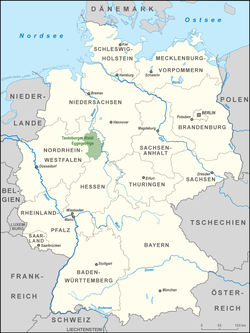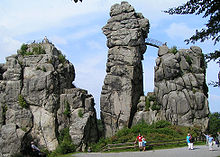Teutoburg Forest / Egge Hills Nature Park

The Teutoburg Forest / Egge Hills Nature Park (
The Teutoburg Forest / Egge Hills Nature Park won the state competition for nature parks, "Naturpark.2009.NRW", with its concept "Natural Health" (Natürlich Gesund).
Geography

The northern part of the nature park begins immediately southeast of
In addition to the two Central Upland ranges that give the park its name, there are elements of the
The regional climate has average annual temperatures of 7 to 8 °C (45 to 46 °F) and average annual precipitation between 625 millimetres (24.6 in) (Warburg) and 1,132 millimetres (44.6 in) (Feldrom).[3]
The region of the nature park is also called the Health Garden of Germany (Heilgarten Deutschland). The reason for this sobriquet is its unique plethora of natural spa resources, such as
Name
The name of the nature park is written – contrary to typographical conventions – with spaces either side of the forward slash. This was agreed by the park authority on 6 December 2007.[4] The German language authority, Duden, gives freedom to firms and associations to do this. Strictly, the typographically or orthographically correct way of writing the name would be "Teutoburg Forest/Egge Hills Nature Park" ("Naturpark Teutoburger Wald/Eggegebirge").
Conservation

Some 60% of the area of the nature park is forested. As a large, contiguous forest, the landscape unit fulfils an ecological balancing function. The Egge Hills and the Teutoburg Forest are thus important components of the state-wide
The mascot of the nature park is the wildcat, whose presence in the region is one of the oldest to have survived to the present day in the state of North Rhine-Westphalia.[5]
Sights

- Externsteine
- Hermannsdenkmal
- Blue zinc violets in the Bleikuhlen at Blankenrode
- Eggeweg and Hermannsweg
- Preußischer and Lippischer Velmerstot
- Köterberg
- Desenberg
- Altenbeken Viaduct
- Fürstenallee
- Rheder Castle near Brakel
- Berlebeck Eagle Observatory
- Iburg near Bad Driburg
- Sparrenberg Castle in Bielefeld
- Dalheim Abbey
- Hardehausen Abbey
- Corvey Abbey
- Detmold Open-air Museum
Literature
- Naturschutzzentrum Senne (pub.): Senne und Teutoburger Wald. tpk-Regionalverlag Bielefeld, 2008, ISBN 978-3-936359-32-9.
- Willy Lippert: Das Eggegebirge und sein Vorland. (Lippert Wanderführer) Eggegebirgsverein. Bad Driburg. 1996. 5th ed.
- Sabine Schierholz: Reiseführer Naturpark Teutoburger Wald / Eggegebirge. tpk-Regionalverlag, 2009, ISBN 978-3-936359-34-3.
- World Habitat Society (pub.): Freizeitkarte Naturpark Teutoburger Wald / Eggegebirge 1:100.000 (published for the Teutoburg Forest / Egge Hills Nature Park), 2009, ISBN 978-3-9811646-1-9.
See also
References
- ^ Naturpark Teutoburger Wald/Eggegebirge
- ^ http://www.naturpark-teutoburgerwald.de/documents/Flyer_Vulkan.pdf (accessed on 5 February 2008)
- ^ a b http://www.naturpark-teutoburgerwald.de/der_naturpark-kurzundknapp.php (accessed on 5 February 2008)
- ^ "Naturpark Teutoburgerwald: Startseite" (PDF). Archived from the original (PDF) on 2016-03-05. Retrieved 2012-12-10.
- ^ http://www.naturpark-teutoburgerwald.de/die_wildkatze.php (accessed on 5 February 2008)
External links
- Teutoburg Forest / Egge Hills Nature Park (in German)
- Westfalen regional - The Teutoburg Forest / Egge Hills Nature Park (in German)
